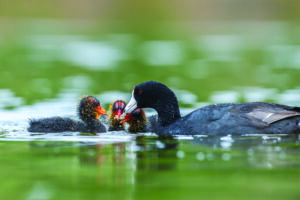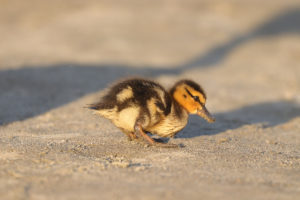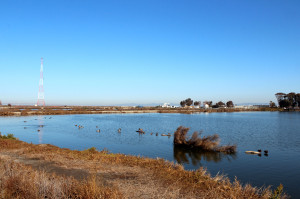San Francisco Bay and its surrounding wetlands become a mallard mecca every winter. Mallards come by the thousands to spend the relatively balmy fall and winter months here while their breeding grounds are locked in snow and ice. And they’re not the only ducks who drop by for a visit: Gadwalls, pintails, northern shovelers, widgeons, scaup, ruddy, bufflehead, goldeneye, and teal also put in an appearance, along with their goose relatives—Canada, Ross, white-fronted, and snow. Clearly there is something about our region that ducks and geese really like!
From October through March, nearly any local body of fresh or salt water will be dotted with ducks you can see from shore. One of the quickest ways to understand who you’re looking at is to see how they eat. We divide ducks into two major feeding styles: dabblers and divers. Mallards are classic butt-in-the-air dabblers. They forage (search for food) in shallow water, feeding on plants and aquatic invertebrates (tiny animals swimming in the water). It’s not unusual to see their rumps more often than their heads. But when you get a glimpse of their heads, the green-headed males are unmistakable and by late winter are probably paired up with a less colorful female mate. Other dabblers include shovelers and widgeons, who spend a great deal of time “sipping and sifting” food from the water while either swimming or walking over the shallows.
Diving ducks completely submerge themselves and swim underwater to get their food. Some prey on fish; others swim to deeper water and forage on vegetation or small animals living in the muddy bottom. The bufflehead is a compact duck, barely half the size of a mallard. Males have a conspicuous white triangular patch covering the back half of the head. These ducks are heavier bodied, with shorter wings, and their legs are placed farther back under their body. This makes it easier for them to dive efficiently and propel themselves through the water. But having heavier bodies and shorter wings means they have to “run” across the water to gain the speed they need to take flight, so they prefer areas with more open water to use as a runway. A mallard’s legs are more centered on its body, so it operates like a paddleboat, and its larger wings make for quick takeoffs. When startled, mallards burst from the water and launch into the air, often quacking as they go, as if scolding us for intruding on their peace.
Accessible duck-watching spots include Lake Merritt and Martin Luther King, Jr. Shoreline in Oakland; Hayward Shoreline; Coyote Hills and Lake Elizabeth in Fremont; Don Edwards National Wildlife Refuge and Palo Alto Baylands in the South Bay; Drakes, Tomales, and Richardson bays in Marin; San Francisco’s Lake Merced; and many others. Don’t forget recreational lakes as well as smaller lakes at community centers and city parks.
Get Out!
You don’t have to go far afield to meet your local waterfowl. All over the Bay Area, naturalists lead winter outings for people of all ages. Of course, you’ll find ducks and geese in any park that has standing water, but visit the same spot with a naturalist and you’ll find a new world of comings and goings, feathered family dramas, and beautiful creatures.
In the East Bay, check out naturalist Bethany Facendini’s family bird walk at Miller-Knox Regional Shoreline in Richmond on January 20 [3-4:30 p.m., info: (510)525-2233]. Or head to Coyote Hills in Fremont for the “Bird Gawk” on January 27 [9-11 a.m., info: (510)795-9385]. At the San Francisco Bay National Wildlife Refuge’s Fremont learning center on January 6 and February 10, kids can create their own birding field guides and then go out in the field to use them [“Family Bird Walk,” 10 a.m.-noon, reservations: (510)792-0222, ext. 43].
In the North Bay, join guides from PRBO Conservation Science for family-friendly bird walks on the first Saturday of each month: January 6 at Petaluma’s Shollenberger Marsh, February 4 at Chimney Rock on Point Reyes, and March 3 at China Camp State Park [all 9-11 a.m., free for PRBO members, $10 otherwise; no RSVP required; info: www.prbo.org, (707)781-2555, ext. 302].
But the Bay and ocean aren’t the only places to meet winter birds. Get a taste of Delta waterfowl habitat at Rush Ranch on Suisun Marsh, the West Coast’s largest remaining brackish marsh. On February 3, join bird expert Joanne Castro for a muddy but rewarding traipse through the ranch [free, 9-11 a.m., info: www.rushranch.org]. And don’t feel left out in the big city, where San Francisco Nature Education offers “Birding for Everyone” walks on the first Saturday of each month, starting near the main gate of the San Francisco Botanical Gardens at Strybing Arboretum [free, 10 a.m.-noon, info: www.sfnature.org].

.jpg)



